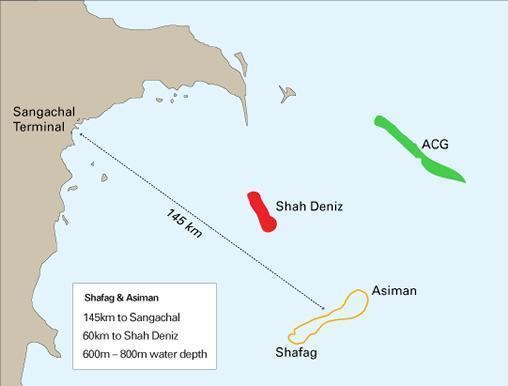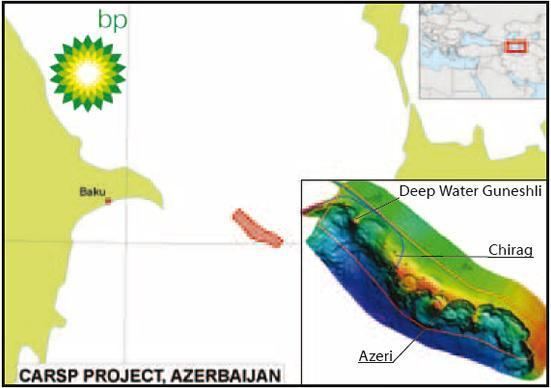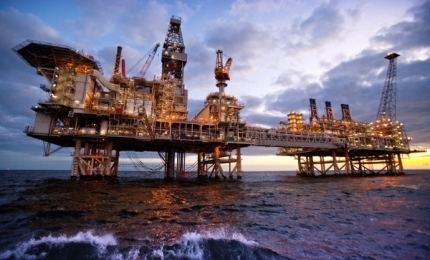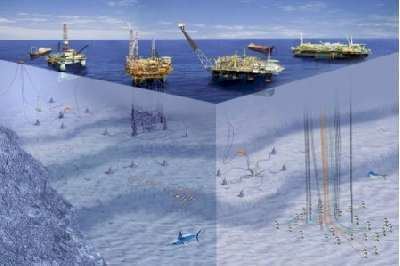Operator AIOC Year of current production of oil 2016 | Offshore/onshore Offshore Peak year 2010 Discovery 1985 Start of production 1997 | |
 | ||
Current production of oil 631,000 barrels per day (~3.14×10^ t/a) Partners | ||
Azeri–Chirag–Gunashli (ACG, Azerbaijani: Azəri-Çıraq-Günəşli) or Azeri–Chirag–Deepwater Gunashli is a complex of oil fields in the Caspian Sea, about 120 kilometres (75 mi) off the coast of Azerbaijan. It consist of Azeri and Chirag oil fields, and the deepwater portion of the Gunashli oil field. An overall estimated area of the development is 432.4 square kilometres (167.0 sq mi). It is developed by the Azerbaijan International Operating Company, a consortium of international oil companies, and operated by BP on behalf of the consortium. The ACG fields have estimated recoverable reserves of about 5 to 6 billion barrels (790 to 950 million cubic metres) of petroleum. As of the end of 2005, the production rate from eight pre-drilled wells at the platform was approximately 240,000 barrels per day (38,000 m3/d).
Contents

The peak of oil production, 835,000 barrels per day (132,800 m3/d), was reached in third quarter of 2010. In the first quarter of 2012 oil production was about 710,000 barrels per day (113,000 m3/d).

BP reports that crude oil from ACG is exported through the Baku–Tbilisi–Ceyhan pipeline to the Mediterranean Sea and the Baku-Supsa Pipeline to Supsa in Georgia, as well as through the Baku-Novorossiysk Pipeline to Novorossiysk in Russia. It is also believed that there are large untapped gas reserves under ACG oilfields. Media reports indicate that according to American Consulting Association IHS CERA (Cambridge Energy Research Associates), the Azeri–Chirag–Gunashli is the third largest oil-field development out of 20 listed. Total investment is estimated at US$20 billion. As of 2008 reports, oil coming from ACG field accounts to nearly 80% of Azerbaijan's total oil output and is expected to bring Azerbaijan potentially $80 billion in profits.
History

Formation of the Azeri–Chirag–Gunashli development started in the beginning of 1990s. In January 1991, the Azerbaijani government announced separate international tenders of exploration rights for Azeri, Chirag, and Gunashli fields. In June 1991, an consortium of Amoco, Unocal, British Petroleum, Statoil, McDermott, and Ramco was formed for a development of Azeri field. Azerbaijan was represented in the consortium by SOCAR. Negotiations were expanded to include all three fields. After Heydar Aliyev became President of Azerbaijan in 1993, talks with foreign companies were stopped and Lukoil was invited to the consortium. Negotiations resumed in 1994. The production sharing agreement was signed by the parties on 20 September 1994 for development of the fields for 30 years. The day of the signing of PSA agreement is celebrated as The Day of Oilworkers in Azerbaijan.

At the first stage, the consortium started development drilling of the Chirag field in August 1997. First oil was produced in November 1997. This development stage was also known as the Early Oil Project (EOP). Originally, producd oil was exported through the Baku–Novorossiysk pipeline. A contract on the oil transportation via Russia to the Black Sea port of Novorossiysk was signed on 18 February 1996. The oil transportation through the pipeline started on 25 October 1997. For the diversification of the export routes, construction of the Baku–Supsa Pipeline was agreed in 1996. The pipeline became operational in 1998 and was officially inaugurated 1999. At the Chirag field, the water injection project was implemented in 1999 and the drilling technology was upgraded in 2000.

Lukoil pulled out of the project in 2003 selling all of its interest to INPEX. The deal was sealed for $1.354 billion.
The second stage of the development consisted of the development of the Azeri field. The development of Azeri field started in 2002. Central Azeri living quarters arrived in Baku in July 2003 and drilling modules arrived in Baku in July 2003. The Central Azeri jacket was completed in March 2004. To accommodate addition oil, the Sangachal Terminal was upgraded in March 2003. After installing the Central Azeri gas pipeline, the Central Azeri platform was launched in July 2004. The platform was installed by October 2004, and production started in February 2005. The Central Azeri compression and water injection platform topsides was launched in July 2005. It injected first gas in May 2006
West Azeri drilling modules arrive in Baku in August 2004 and the platform launched in May 2005. The platform's topsides was installed in September 2005 and production started in January 2006. East Azeri drilling modules and quarters arrived in Baku in June 2005 and the platform was launched in March 2006. The topside was installed in March 2006 and the production began in October 2006.
The Deepwater Gunashli pre-drilling program started in December 2005. Drilling modules and quarters arrived in Baku in June 2006. The paltform became operational in April 2008.
On 23 November 2009, Devon Energy announced it would sell its share in ACG. On 29 March 2013, Hess sold its stake to ONGC for $1 billion.
Ownership
Shareholders of the Azeri-Chirag-Gunashli development include BP with 35.78% of stakes, SOCAR (11.64%), Chevron Corporation (10.28%), Inpex (10.96%), Statoil (8.56%), ExxonMobil (8.00%), TPAO (6.75%), Itochu (4.3%) and ONGC Videsh (2.72%). BP with major stake in the ownership is leading the AIOC consortium.
Production
With 3 stages completed and 7 operational platforms functional, total production from Azeri–Chirag–Gunashli is more than 1 million barrels (160,000 m3) a day. During the first three quarters of 2009, over 224 million barrels (35.6×10^6 m3) of oil were produced from the Chirag, Central Azeri, West Azeri, East Azeri and Deep Water Gunashli platforms. As per BP's report, Chirag had 19 wells in operation (13 of which are oil producers and 6 - water injectors) with an overall production of 105,300 bbl/d (16,740 m3/d). Central Azeri (CA) had 18 wells (13 of which are oil producers and 5 - gas injectors) with production of 185,800 bbl/d (29,540 m3/d). West Azeri (WA) had 18 wells in operation (14 of which are oil producers and 4 - water injectors with production of 275,200 barrels per day (43,750 m3/d). East Azeri (EA) had 13 wells in operation (9 of which are oil producers and 4 - water injectors) with an overall production 139,400 barrels per day (22,160 m3/d) for the first three quarters of 2009. Deep Water Gunashli (DWG) had 17 wells (9 oil producers and 8 water injectors) in operation with production of 116,400 barrels per day (18,510 m3/d) of oil.
Azerbaijan also gets approximately 10–11 million cubic metres (350–390 million cubic feet) of casing head gas per day extracted from ACG block. The gas is supplied by BP free of charge. Azerbaijan received over 1 billion cubic meters of gas from these fields in the 1st quarter of 2009. Current recovery comes to nearly 27 million cubic meters of casing head gas a day. A portion of gas is routed to national gas transportation system of Azerbaijan. Some is used as source of fuel at the platforms.
Casing head gas from platforms in central, western and eastern parts of Azeri field is supplied to Sangachal terminal via 28 inch subsea gas pipeline to distributive system of Azerigaz CJSC to use on the local market. A portion of casing head gas extracted at Chirag platform is directed to SOCAR's compressor station (the State Oil Company of Azerbaijan) to Oil Rocks field via 16 inch subsea gas pipeline. The rest of the gas from Azeri–Chirag–Guneshli platforms are pumped through intra field subsea gas pipeline to a platform for repeated pumping in a layer to support layer pressure. As of September 2009, 164.2 million tonnes of oil and 37 billion cubic meters of associated gas have been produced and 80.3 million cubic meters of water and 13 billion cubic meters of gas have been injected into layers since the beginning of production in ACG fields in 1997.
Routes of transportation
The oil from the ACG field was pumped to Sangachal terminal south of Baku and from there routed to foreign markets by Baku-Supsa pipeline, Baku–Novorossiysk pipeline and Baku–Tbilisi–Ceyhan pipeline. An interactive map shows all current export routes.
